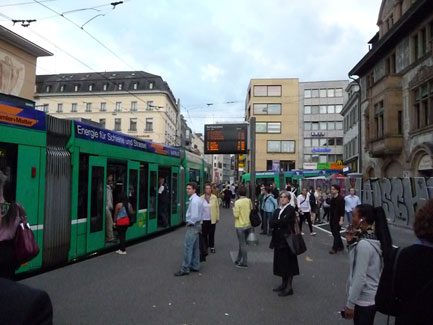Experiencing Cities: Convenience and Carbon

One of the delights of an academic life is the opportunity to spend time in the summer traveling on research trips to foreign countries; there really is nothing like studious foreign travel to give useful perspectives on conditions here in America. This year I went home to England and traveled to several other European countries without a car, and focused on how the transportation infrastructure of various cities compared to Charlotte.
My main conclusions were no surprise, and confirmations of what many know from previous experience: 1) it’s usually a lot easier and more pleasant to move around European cities by public transportation (but avoid the infamous 64 bus in Rome!); and 2) this gives European cities several advantages in global competitiveness over cities here in the States. This is a key deficit for Charlotte to make up.
 Take Basel, Switzerland, for example: not a top-ranked city, but a pleasant stopover en route from London to Italy. My wife and I arrived mid-afternoon at the main train station, walked a quarter-mile and checked into a standard but pleasant business hotel. We wanted to visit the Tinguely Museum, designed by Swiss architect Mario Botta, and devoted to the works of sculptor Jean Tinguely. This artist’s last piece, Cascade, hangs in Charlotte’s Carillon building uptown, and to amplify the Charlotte connections, Tinguely was once married to Niki de Saint-Phalle, whose wonderful Firebird sculpture sits on South Tryon Street outside the Bechtler Museum of Modern Art — also designed by Botta.
Take Basel, Switzerland, for example: not a top-ranked city, but a pleasant stopover en route from London to Italy. My wife and I arrived mid-afternoon at the main train station, walked a quarter-mile and checked into a standard but pleasant business hotel. We wanted to visit the Tinguely Museum, designed by Swiss architect Mario Botta, and devoted to the works of sculptor Jean Tinguely. This artist’s last piece, Cascade, hangs in Charlotte’s Carillon building uptown, and to amplify the Charlotte connections, Tinguely was once married to Niki de Saint-Phalle, whose wonderful Firebird sculpture sits on South Tryon Street outside the Bechtler Museum of Modern Art — also designed by Botta.
The museum was on the other side of the city. “How can we get there?” we asked the receptionist. “No problem!” she replied. “Here, take these two complimentary transit passes, valid all day, hop on the number 2 tram outside, go one stop, catch a 36 bus and it takes you right there!”
Twenty minutes and four miles later we were at the museum on the banks of the Rhine, having traversed a variety of suburbs, a linear park, and passed directly by a large soccer stadium for 40,000 fans integrated with other recreation facilities. When we had our fill of Tinguely’s wonderful, whimsical sculptures, we caught the bus back. So easy! That evening we went out on the town (to test the efficiency of the infrastructure, of course). “How do we get to some good, cheap restaurants?” we asked the ever-helpful receptionist. “Catch the number 8 tram from across the street,” she replied. “That takes you right into the center of town.”
After a pleasant meal we walked around taking photographs and notes, and as it got dark, hopped on a different tram and headed back to the train station, from where it was a five-minute walk to the hotel. In seven hours we had explored several interesting parts of a foreign city, seen great art, had good food and wine and sampled some excellent urbanism, all courtesy of a seamless, city-wide transit infrastructure. What’s more, we achieved this with a very low carbon footprint.
 Charlotte’s got great art museums, sports stadia and many fine restaurants. There are several parts of the center city that are pleasant to walk around, but it’s difficult to join this city’s amenities together in an energy efficient manner. Try composing a similarly convenient itinerary arriving at Charlotte’s airport, or, heaven forbid, its Amtrak station. It’s all but impossible by public transit; something could be managed via rental car or taxi — but with a much higher expenditure of cost, energy and emissions.
Charlotte’s got great art museums, sports stadia and many fine restaurants. There are several parts of the center city that are pleasant to walk around, but it’s difficult to join this city’s amenities together in an energy efficient manner. Try composing a similarly convenient itinerary arriving at Charlotte’s airport, or, heaven forbid, its Amtrak station. It’s all but impossible by public transit; something could be managed via rental car or taxi — but with a much higher expenditure of cost, energy and emissions.
Ease of moving around a city is important for its economic development, and Basel, of course, is a lot luckier in many respects than Charlotte. Historically it’s more compact and has assembled its transportation network over many decades, never giving up public transit in favor of private single occupancy vehicles as did Charlotte and 99% of other American cities.
Cities such as Basel are thus better positioned to respond effectively to future changes in lifestyle that may be occasioned by external factors such as climate change, volatile energy prices and diminishing oil supplies. Charlotte, by contrast, faces some daunting, self-imposed challenges as it struggles towards a more sustainable urban future. This has been highlighted recently by an outpouring of opposition to the planned cross-town streetcar coupled with the city’s financial inability to capitalize on the success of its first light rail line. Several of my future columns on this website will focus on these questions of urban infrastructure, from both design and political perspectives. So, next time the question: “Why do we demonize infrastructure?”
Views expressed in this commentary are entirely those of the author(s) and do not necessarily represent the views of the UNC Charlotte Urban Institute, its staff, or the University of North Carolina at Charlotte.
Photographs by David Walters